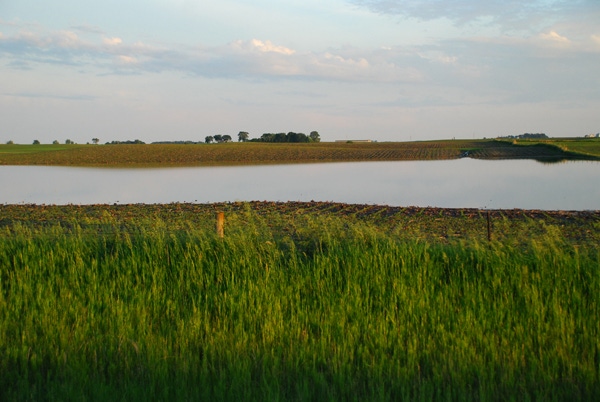May 31, 2013

Over the last week, some areas of South Dakota and other Corn Belt states have received over 6 in. of rainfall, leading to ponded or flooded areas in fields. Water saturated or waterlogged soils lack enough oxygen for root respiration and many wonder, “How long can corn and soybeans plants at early growth stages survive in these waterlogged soils?”
We know that the crop growth stage, variety/hybrid, duration of ponding/saturation, soil type, soil/air temperature and other factors can affect the survival of corn and soybean plants under these waterlogged conditions. Unfortunately other factors reduce plant population related to flooding, including crusting, plants covered in sediment or buried under residue, and increase in seed/seedling diseases like damping-off in soybean.
Currently, the crop growth stages of most corn and soybean range from germination to V3 and germination to V1, respectively. At these early growth stages (germination, emergence, early vegetative), both corn and soybean plants are negatively impacted quite quickly by waterlogged conditions. Crops that are not completely submerged have some limited capacity for diffusion of oxygen to occur from the shoot to the root, which increase survival time. Oxygen is needed by plant cells for growth and development, including germination. Waterlogged conditions experienced by corn seed for 2 or more days is a long enough time to decrease final corn emergence and is more detrimental at soil temperatures in the 70s than the 50s (Fausey and McDondald, 1985). In general, young corn plants can survive about 2-4 days of flooded conditions.
The effect of waterlogging on soybean germination and early growth has not been widely studied or written about. Presence of waterlogged soils at any time and for any duration during the germination process in soybeans will reduce the final germination and emergence percentage (Wuebker et al., 2001). A germination decrease of 20-43% can occur from a 48-hour flooding that occurs after the start of seed imbibition or swelling (Wuebker et al., 2001). Even after waterlogged conditions are removed, researchers have found that seedling growth was reduced by more than 50% from 24 to 48 hours of flooding when temperatures were near 77° F.
However, on-farm research and observations tell us not to give up hope as soybean plants at the V2-V3 growth stage can survive on soils flooded up to eight days. If enough plants survive the temporary soggy conditions, yields in depressional areas can be equal to or better than upland areas during dry summers. Soybean yield reductions from 0 to 100% can occur from three days of flooding at the V2 to V3 stage compared to adjacent non-flooded areas (Sullivan et al., 2001).
Like what you're reading? Subscribe to CSD Extra and get the latest news right to your inbox!
Low plant populations and shorter plants resulting from ponding/flooding often result in decreased yield. The probability of yield loss increases as final soybean plant population decreases below 100,000 plants/acre.
Growers needing to replant acres lost due to flooding should be able to find seed in the maturity range they need, but won’t have the luxury of being picky in their hybrid or variety selection. Delayed/ prevented planting provisions and South Dakota final planting dates should be reviewed.
You might also like:
Late-Planted Soybean Acreage, Yield Concerns
You May Also Like




